Search Results for Tag: Khumbu Icefall
In their husbands’ Everest footsteps
Mount Everest took their husbands. And the fathers of their children. Nevertheless, Nima Doma Sherpa and Furdiki Sherpa want to climb the highest mountain on earth this spring. “We are doing our expedition for the respect of our late husbands because they were mountaineers too,” Nima Doma replies to my question about the purpose of their project. “And we want to motivate all the widows.” Everest has left a lot of single mothers behind. According to the mountaineering chronicle “Himalayan Database”, 37 Sherpas have died there in the past 20 years alone. Furdiki’s husband, Mingma Sherpa, belonged to the so-called “Icefall Doctors” who set up and secure the route through the Khumbu Icefall every year. The 44-year-old died in a fall into a crevasse on 7 April 2013. One year later, on 18 April 2014, Nima Doma Sherpa’s husband, Tshering Wangchu Sherpa, was one of the 16 Nepalese victims of the major avalanche accident in the Icefall.
![]() read more
read more
Everest winter expedition: On the double to Camp 1
This went fast. In just four days, the Spaniard Alex Txikon and the Sherpas Tenzing Gyalzen, Gelje, Cheppal, Walung Dorji and Pasang Norbu have completed the route through the Khumbu Icefall and reached Camp 1 at 6,050 meters. “Great job, we are very happy,” says Alex, adding that it was really hard work, each of them had carried between 25 and 35 kilos. The 36-year-old Basque points out that it took the six climbers five days less for this first major task than his team during the failed winter attempt in 2017 – despite the fact that at that time eleven, i.e. five more expedition members had been involved in the work. “The route through the icefall is very complex and required our full concentration,” says Alex. According to his words, he had searched together with the “Icefall Doctor” Gelje Sherpa for the ice areas with the lowest risk of collapsing.
![]() read more
read more
Same route as in the accident year 2014
Has the memory of the Everest tragedy in 2014 faded so quickly? According to the Kathmandu-based newspaper “The Himalayan Times”, the “Icefall Doctors” have relocated the route through the Khumbu Icefall for the upcoming season to the left side of the ice labyrinth, just below the ice-loaded West Shoulder. On 18 April 2014, an ice avalanche had swept down from there and killed 16 Nepalese climbers. In spring 2015 (this season also ended prematurely due to the devastating earthquake in Nepal) and in 2016 too, the Sherpas, who were responsible for securing and maintaining the route through the Icefall, had chosen a variant on the right side.
![]() read more
read more
Route via the Khumbu Icefall is prepared
Once more it is served on Mount Everest. For three days, the Basque Alex Txikon, six Sherpas and two “Icefall Doctors” worked to restore the route via the Khumbu Icefall up to Camp 1 at more than 6,000 meters. 60 percent of the route had to be renewed, because the hard weather conditions of the past two weeks had left their mark in the ice labyrinth, the team of the 35-year-old Spaniard said. “It has been hard days refitting the route,” Alex noted on Facebook. After today’s rest day, Txikon and Co. want to ascend tomorrow to Camp 2 at 6,400 meters.
Time to grind the teeth
“I know that every time I go up, my strength is decreasing and therefore the chances of summit too,” Alex wrote in his blog. “But I’m a bit stubborn and I like to climb and fight it. It is time to grind my teeth.”
As reported, Txikon had had to interrupt his winter attempt involuntarily because the Nepalese expedition operator Seven Summit Treks had ordered the entire team back to Kathmandu after the failed first summit attempt. On Saturday, Alex had returned to the Everest Base Camp by helicopter.
Alex Txikon’s Everest dream team
Danger welds together. When Alex Txikon returned to Base Camp after six exhausting and exciting days on the slopes of Mount Everest, he hugged every Sherpa who had accompanied him. “In this team everyone knows what needs to be done,” the 35-year-old Basque writes in his blog. The appreciation is mutual. In Alex’ words, Norbu Sherpa told him during the descent: “I believe that for more than 20 or 30 years, no westerner has done what you are doing.” Like the six Sherpas, Txikon had carried up loads of more than 30 kilograms through the Khumbu Icefall and further up.
![]() read more
read more
Txikon reaches Camp 2 on Everest
Sunny, but extremely cold. This is what the weather forecast predicts for the next days on Mount Everest. In addition, the wind is to refresh. Temperatures between minus 20 and minus 30 degrees Celsius are expected, Alex Txikon informs. In addition, the wind is to refresh. Nevertheless, the team set off from Base Camp today and reached after seven hours the site of Camp 2 at 6,400 meters. Alex, his Spanish countryman Carlos Rubio and nine Sherpas had previously secured the way through the Khumbu Icefall and pitched up Camp 1 at 6,050 meters, at the entrance of the Western Qwm. It was said, that the team might climb up even to Camp 3 at 7,400 meters within the next days. The climbers are expected back in Base Camp on next Sunday or Monday.
![]() read more
read more
An Icefall Doctor himself
At the moment Alex Txikon may feel on Mount Everest a bit like Edmund Hillary. Like the first ascender from New Zealand and his companions in 1953, the Basque must play an active part in finding a way through the dangerous Khumbu Icefall above Base Camp and in carrying material needed to secure the route. For example aluminium ladders to cross the deep crevasses in the Icefall. With a weight of about five kilograms, such a ladder is not too heavy but bloody bulky while climbing through the ice. Real back-breaking work, as the video shows which the 35-year-old sent today from Everest Base Camp:
As reported, Alex, along with his Spanish countryman Carlos Rubio, wants to scale Mount Everest in winter, for the first time since 1993 – without bottled oxygen. The two climbers and nine Sherpas first have to make their way through the dangerous Icefall. Txikon has estimated this work for up to four weeks.
Pretty exclusive experience
As in Hillary’s days, the Spanish expedition is currently the only one on the highest mountain on earth. What a contrast to spring, when year after year several hundred mountaineers from dozens of commercial expeditions turn the Base Camp into a small tent town!
When the clients arrive there at an altitude of 5,300 meters in April, usually the so-called “Icefall Doctors” have already prepared and secured the way through the Icefall. This team of eight Sherpas also ensures that the route remains accessible throughout the climbing season until its end early June. The highly specialized Sherpas are selected and paid by the Sagarmatha Pollution Control Committee (SPCC), an organization that originally only cared about the environmental protection in the National Park around Mount Everest. Since 2000, the SPCC has also been responsible for the route through the Khumbu Icefall on behalf of the Government of Nepal. In spring 2014, 16 Nepalese climbers were killed in an avalanche in the Icefall.
Even if it turns out that Alex Txikon is not able to reach the summit at 8,850 meters this winter – his experience of working as a non-Sherpa as Icefall Doctor is pretty exclusive.
Ten popular Everest errors
The Everest spring season is gaining momentum. The Base Camp on the Nepalese side of Mount Everest is filling. According to the government in Kathmandu, 279 climbers from 38 countries have registered for the highest mountain on earth. The Icefall Doctors have meanwhile prepared the route all the way up to Camp 2 at 6,400 meters. The teams who want to climb Everest from the Tibetan north side, have also received now their permits from the Chinese authorities and are heading to Tibet. It’s going to kick off there too. Before the media Everest season begins, I would like to correct some reoccurring errors.
![]() read more
read more
Securing Everest jobs of the future
He is one of the Sherpas who stay well clear of Mount Everest this year. “I simply haven’t got the time,” says Dawa Sherpa Gyaljen, when I meet him in a cafe in Kathmandu during my visit Nepal. The 29-year-old is working for a trekking operator. “Maybe I’ll get the chance in 2017 again. I have been asked if I would lead an Everest team next year. Let’s see whether I can take as much vacation.” The Sherpa, who was born in the Khumbu region in a small village west of Namche Bazaar, has reached the highest point on earth already four times: in 2005, 2007, 2008 and 2009. The upcoming spring season could set the course for the future, Dawa believes.
![]() read more
read more
Dorje’s Everest sabbatical
Dorje Sherpa is familiar with Everest disasters. In 1996, 20 years ago, he reached the summit of the highest mountain on earth for the first time. Then he belonged to the IMAX film team of the American David Breashears, when a storm in the summit area killed eight climbers within 24 hours. “We were then in Camp 2 at 6,400 meters”, the 50-year-old tells me in his “Buddha Lodge” in the village of Phakding, which lies on the popular trekking route to Everest Base Camp.
![]() read more
read more
With nine finger stumps to the top of Everest?
It has gone out of style to climb Mount Everest in fall. This happened even though some of the most spectacular summit successes on the highest mountain in the world have been made in the post-monsoon period: Remember only the first ascent through the Everest Southwest Face by the British Doug Scott and Dougal Haston in September 1975 or the success of the US-American Carlos Buhler, Kim Momb and Lou Reichardt via the East Face in October 1983. However, the climbing season has moved more and more into spring since commercial expeditions have taken over on Everest – due to higher temperatures compared to fall and to the usually lower risk of avalanches. Since 2000, only 36 summit successes have been recorded in September or October – next to nothing compared with over 5,000 ascents in spring since the turn of the millennium. The last ascent to the top of Everest in fall dates from five years ago: In October 2010, the American Eric Larsen and five Sherpas reached the highest point at 8,850 meters. This fall, there will be another attempt to climb Everest from the Nepalese south side. According to the “Himalayan Times” the so-called “Icefall Doctors” – a group of high specialized Sherpas – arrived at Base Camp in order to fix a route through the Khumbu Icefall.
![]() read more
read more
Rather far on the right side
Apparently, the new route through the Khumbu Icefall is more than a little course correction. That is indicated by the images that the US guide Garrett Madison has published in his blog. Expedition members of his Madison Mountaineering team had flown over the icefall above Everest Base Camp by helicopter and had looked from the air where the so-called “Icefall Doctors” set up the route for this spring season. The images show that the route leads – seen from below – much further to the right side of the ice labyrinth than expected. Closer to Nuptse, further away from the West Shoulder of Everest, from where an ice avalanche had released on 18 April 2014 that had killed 16 Nepalis. “It appears that climbers will have to negotiate broken ice as before, and perhaps more vertical ladders”, Garrett wrote adding that there was at least one section that had four vertical ladders tied together to ascend up a very large ice cliff.
![]() read more
read more
Dawa Gyaljen Sherpa: “Cold war inside”
He was one of the first at the scene. After the fatal avalanche at the Khumbu Icefall on 18 April 2014, Dawa Gyaljen Sherpa rushed down from Camp 2 to help the buried climbers. “On the spot, we encounter dead bodies and blood everywhere. There were a row of dead bodies in one main rope swept into the crevasse”, the 28-year-old Sherpa wrote to me in 2014. “When we pulled the rope, we found the body one after another in the same crevasse. Some of the dead bodies were buried into the snow and we could see only the boots, it seemed those bodies were upside down.” 16 Nepalese were killed in the avalanche, two weeks later the Base Camp was empty, the season finished. Dawa Gyaljen Sherpa has summited Everest four times, he did it for the first time when he was 19 years old. Later Dawa studied in UK. Now he’s living in Kathmandu. I asked him what he thinks about the upcoming Everest spring season. He replied openly. A Sherpa point of view, an interesting insight.
![]() read more
read more
Russell Brice: “At last”
Russell Brice breathes out. “At last”, the 62-year-old New Zealander, head of the expedition operator Himalayan Experience, replies to my question on what he thinks about the planned new route through the Khumbu Icefall on Mount Everest. “We have been asking the SPCC (Note: The Sagarmatha Pollution Control Comitee is responsible for the route through the icefall.) to put the route more central since 2012. Now at last they have listened to the foreign operators instead of the local Sherpas who asked for the route to be moved so as they could travel faster … but not so safely.” Brice doesn’t expect that the new route will take the clients as much time as SPCC president Ang Dorjee Sherpa estimates: “It will take only about one hour longer, not three to four hours. You see there are not many people around these days who have been this way. But I have.”
![]() read more
read more
German doctor wants to help Sherpa families in the long term
18 April has changed many things: on Mount Everest, in the lives of the families of the 16 avalanche victims – and also for Matthias Baumann. The 42-year-old trauma surgeon from the German town of Esslingen was the expedition doctor in the team of the Argentine twin brothers Damian and Willie (Guillermo) Benegas and actually wanted to climb Everest in his second attempt, on the Nepalese south side. In 2011, his first attempt on the Tibetan north side had failed at 8600 meters: When he wanted to change his oxygen bottle at the Second Step, the key point of the normal route, Matthias realized that his Sherpa had packed an empty instead of a full bottle.
Three years later, this spring, Baumann climbed through the Khumbu Icefall, on the day before the avalanche. “I knew that avalanches had been coming down from the West Shoulder of Everest for four or five years. Up there, the seracs are threatening”, Matthias told me. Even if the fun at climbing gained the upper hand, the respect remained. “I was always looking up to the seracs.” On the following day, the Khumbu Icefall became a death trap for 16 Nepalese climbers. With other physicians, the German doctor took care of the injured climbers who were brought down to the base camp. After the end of the expedition Matthias visited almost all the families of the Nepalese who had lost their lives – and launched a fundraiser for them.
![]() read more
read more





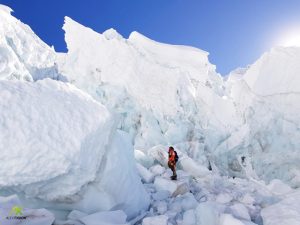
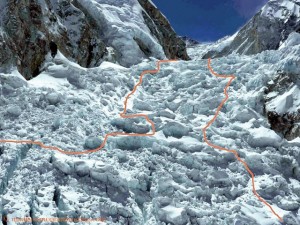
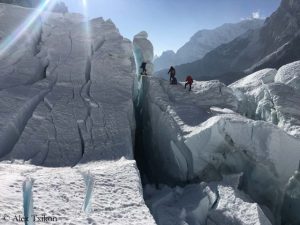
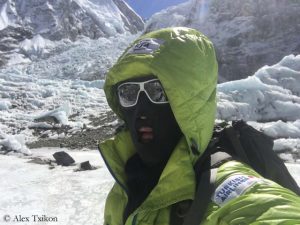
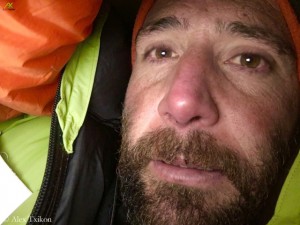
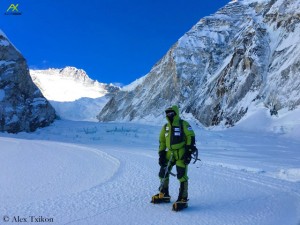
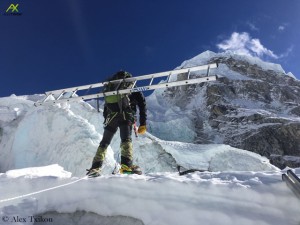
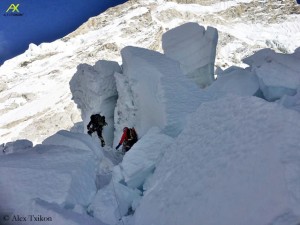
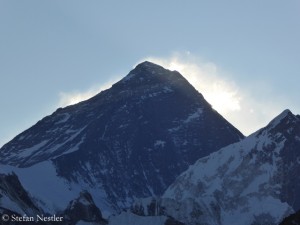
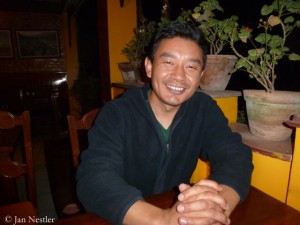
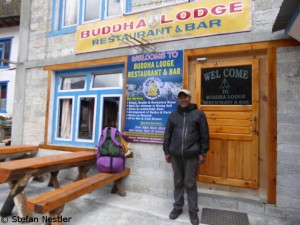
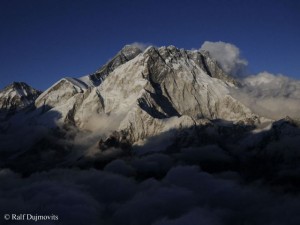

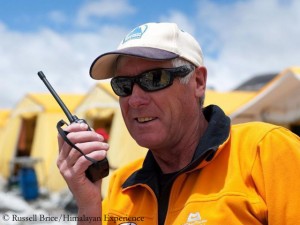
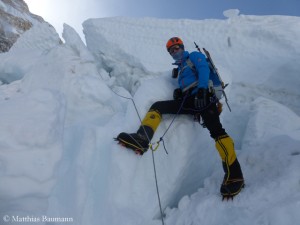





Feedback